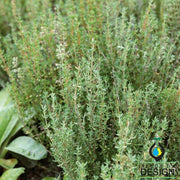Growing Non-GMO German Winter Thyme Herb Seeds
When growing from seed, winter thyme is best started indoors. Scatter the seeds over the growing medium and lightly cover them with more soil. Mist the seeds but do not saturate them. When the seeds have sprouted, thin them out so only the strongest and biggest ones are left. Once they have some substantial roots, harden them off by slowly transitioning them to their growing area. Transplant the seedlings into a desired sunny spot. Avoid standing water near the roots. Once established, Thyme rarely needs to be watered or fertilized. It may require mulching in very cold climates.
German Winter Thyme in the Herb Garden
Thyme has a plethora of uses in the herb garden. Well known for its culinary utility, it also has many other abilities. Thyme is known to deter pests from other plants, making it a fantastic ground cover and companion plant. Many people also claim thyme to have incredible medicinal purposes. Keep a few thyme plants outside your window to quickly toss into salads, beans, soups, stews, sauces, pickles, and many Mediterranean dishes. It provides outstanding flavoring for poultry and fish dishes as well.
Harvesting German Winter Thyme
When starting German Thyme from seed, leaves should only be harvested minimally for the first 1-2 years to encourage root development. Once the plant has become established, harvest up to 1/3rd of the size of the plant up to 3 times throughout the year. Leaves may be dried and preserved for extended use.
About German Winter Thyme Garden Seeds
It is often prescribed by herbalists for intestinal worms, gastrointestinal ailments, bronchial problems, laryngitis, diarrhea, and lack of appetite. It has antiseptic properties and can be used as a mouthwash, skin cleanser, anti-fungal agent for athlete's foot, and an anti-parasitic for lice, scabies, and crabs. Thyme can be helpful for skin inflammations and sores by making a poultice of mashed leaves.
Thyme is originally from the Mediterranian and pairs very well with other flavors native to that area.
Performs in xeriscapes and dry climates.
Grasp one end of a spring between two fingers and slide two fingers from the other hand down the stem to remove the leaves.
Thyme is frequently grown and made into essential oil and then sold at a high price. Growing your own allows you to get similar benefits at a fraction of the cost.
German Winter Thyme is a fantastic landscaping plant as well. Using it as a ground cover or between pavers is more environmentally friendly than traditional grass. When it is stepped on, it fills the area with its pleasant aroma!
Stories From Our Gardeners
"I have grown thyme in a greenhouse, an outdoor garden, and even inside my apartment window. When other plants struggle, it seems to do well!"
 - Lara Wadsworth, Seeds by Design Writer - Lara Wadsworth, Seeds by Design Writer
|
German Winter Thyme Seeds Per Package:
500 mg - Wholesale - Approximately 705 Seeds
0.25 oz - Wholesale - Approximately 10,000 Seeds
1 oz - Bulk Seeds - Approximately 40,000 Seeds
4 oz - Bulk Seeds - Approximately 160,000 Seeds
1 lb - Bulk Seeds - Approximately 640,000 Seeds
5 lb - Bulk Seeds - Approximately 3,200,000 Seeds







 - Lara Wadsworth, Seeds by Design Writer
- Lara Wadsworth, Seeds by Design Writer